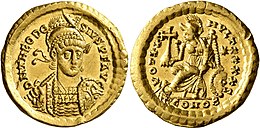
Back Solido bizantín AN صوليدوس Arabic Солід Byelorussian Солид Bulgarian Sòlid (moneda) Catalan Solidus Czech Solidus Danish Solidus German Σόλιδος Greek Solido (monero) Esperanto
This article has multiple issues. Please help improve it or discuss these issues on the talk page. (Learn how and when to remove these messages)
|


The solidus (Latin 'solid'; pl.: solidi) or nomisma (Greek: νόμισμα, romanized: nómisma, lit. 'coin') was a highly pure gold coin issued in the Later Roman Empire and Byzantine Empire. The early 4th century saw the solidus introduced in mintage as a successor to the aureus, which was permanently replaced thereafter by the new coin, whose weight of about 4.5 grams remained relatively constant for seven centuries.
In the Byzantine Empire, the solidus or nomisma remained a highly pure gold coin until the 11th century, when several Byzantine emperors began to strike the coin with less and less gold. The nomisma was finally abolished by Alexios I Komnenos in 1092, who replaced it with the hyperpyron, which also came to be known as a "bezant". The Byzantine solidus also inspired the zolotnik in the Kievan Rus' and the originally slightly less pure gold dinar first issued by the Umayyad Caliphate beginning in 697.
In Western Europe, the solidus was the main gold coin of commerce from late Roman times to Pepin the Short's currency reform in the 750s, which introduced the silver-based pound-shilling-penny system.
In Late Antiquity and the Middle Ages, the solidus also functioned as a unit of weight equal to 1⁄72 Roman pound (approximately 4.5 grams).